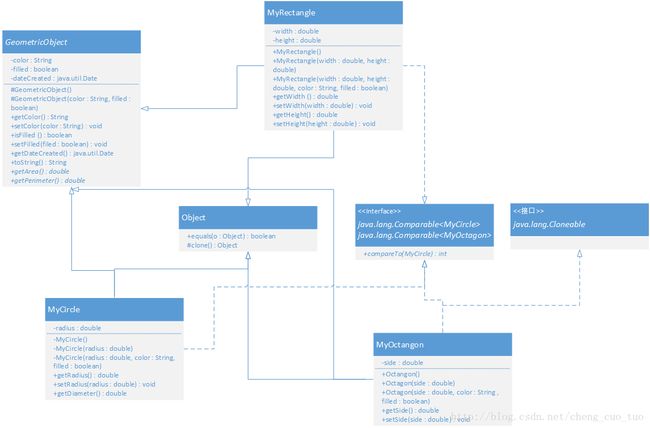java语言程序设计 第十三章 (13.9、13.10、13.11、13.12)
程序小白,希望和大家多交流,共同学习
由于13.9、13.10、13.11、13.12继承自相同的父类,所以将其写在一起
UML类图也画在一起了。public abstract class GeometricObject
{
private String color;
private boolean filled;
private java.util.Date dateCreated;
protected GeometricObject()
{
dateCreated = new java.util.Date();
}
protected GeometricObject(String color, boolean isFilled)
{
this.color = color;
this.filled = filled;
dateCreated = new java.util.Date();
}
public String getColor()
{
return color;
}
public void setColor(String color)
{
this.color = color;
}
public boolean isFilled()
{
return filled;
}
public void setFilled(boolean filled)
{
this.filled = filled;
}
public java.util.Date getDateCreated()
{
return dateCreated;
}
@Override
public String toString()
{
return "created on " + dateCreated + "\ncolor: " + color + "\nand filled: " + filled;
}
public abstract double getArea();
public abstract double getPerimeter();
}public class MyCircle
extends GeometricObject implements Comparable<MyCircle>
{
private double radius;
public MyCircle()
{
}
public MyCircle(double radius)
{
this(radius, "white", false);
}
public MyCircle(double radius, String color, boolean filled)
{
super(color, filled);
this.radius = radius;
}
public double getRadius()
{
return radius;
}
public void setRadius(double radius)
{
this.radius = radius;
}
public double getDiameter()
{
return 2 * radius;
}
@Override
public double getArea()
{
return Math.PI * radius * radius;
}
@Override
public double getPerimeter()
{
return 2 * Math.PI * radius;
}
@Override
public int compareTo(MyCircle circle)
{
if (getArea() < circle.getArea())
{
return -1;
}
else if (getArea() > circle.getArea())
{
return 1;
}
else
return 1;
}
@Override
public boolean equals(Object o)
{
if (((MyCircle)o).getRadius() == radius)
{
return true;
}
else
return false;
}
}public class MyRectangle
extends GeometricObject implements Comparable
{
private double width;
private double height;
public MyRectangle()
{
}
public MyRectangle(double width, double height)
{
this(width, height, "white", false);
}
public MyRectangle(double width, double height, String color, boolean filled)
{
super(color, filled);
this.width = width;
this.height = height;
}
public double getWidth()
{
return width;
}
public void setWidth(double width)
{
this.width = width;
}
public double getHeight()
{
return height;
}
public void setHeight(double height)
{
this.height = height;
}
@Override
public double getArea()
{
return width * height;
}
@Override
public double getPerimeter()
{
return 2 * (width + height);
}
@Override
public int compareTo(MyRectangle rectangle)
{
if (getArea() > rectangle.getArea())
{
return 1;
}
else if (getArea() < rectangle.getArea())
{
return -1;
}
else
return 0;
}
@Override
public boolean equals(Object o)
{
if (compareTo((MyRectangle)o) == 0)
{
return true;
}
else
return false;
}
} public class MyOctagon
extends GeometricObject implements Comparable<MyOctagon>, Cloneable
{
private double side;
public MyOctagon()
{
}
public MyOctagon(double side)
{
this(side, "White", false);
}
public MyOctagon(double side, String color, boolean filled)
{
super(color, filled);
this.side = side;
}
public double getSide()
{
return side;
}
public void setSide(double side)
{
this.side = side;
}
@Override
public double getArea()
{
return (2 + 4 * Math.sqrt(2)) * side * side;
}
@Override
public double getPerimeter()
{
return 8 * side;
}
@Override
public int compareTo(MyOctagon octagon)
{
if (getArea() > octagon.getArea())
{
return 1;
}
else if (getArea() < octagon.getArea())
{
return -1;
}
else
return 0;
}
@Override
public String toString()
{
return super.toString() + "\nside : " + side;
}
@Override
public Object clone()
{
try
{
MyOctagon octagon = (MyOctagon)super.clone();
return octagon;
}
catch (CloneNotSupportedException ex)
{
return null;
}
}
}下面是各个子类的测试类,还有面积求和类
import java.util.Scanner;
import java.util.Arrays;
public class TestMyCircle
{
public static void main(String [] args)
{
MyCircle circle1 = new MyCircle(2.5);
MyCircle circle2 = new MyCircle(4.5);
MyCircle circle3 = new MyCircle(2.5);
MyCircle circle4 = new MyCircle(4.5);
MyCircle circle5 = new MyCircle(2.5);
MyCircle circle6 = new MyCircle(4.5);
System.out.println("circle1 equals circle2 ? " + circle1.equals(circle2));
System.out.println("circle1 equals circle3 ? " + circle1.equals(circle3));
MyCircle[] circles = {circle1, circle2, circle3, circle4, circle5, circle6};
Arrays.sort(circles);
for (MyCircle circle : circles )
{
System.out.println(circle.getArea());
}
}
}import java.util.Arrays;
public class TestMyRectangle
{
public static void main(String [] args)
{
MyRectangle rectangle1 = new MyRectangle(2, 4);
MyRectangle rectangle2 = new MyRectangle(3, 5);
MyRectangle rectangle3 = new MyRectangle(2, 4);
MyRectangle rectangle4 = new MyRectangle(3, 5);
MyRectangle rectangle5 = new MyRectangle(2, 4);
MyRectangle rectangle6 = new MyRectangle(3, 5);
System.out.println("rectangle1 equals rectangle2 ? " + rectangle1.equals(rectangle2));
System.out.println("rectangle1 equals rectangle3 ? " + rectangle1.equals(rectangle3));
MyRectangle[] rectangles = {rectangle1, rectangle2, rectangle3, rectangle4, rectangle5, rectangle6};
for (MyRectangle rectangle : rectangles)
{
System.out.println(rectangle.getArea());
}
}
}public class TestMyOctagon
{
public static void main(String [] args)
{
MyOctagon octagon1 = new MyOctagon(5);
System.out.println(octagon1.getArea());
MyOctagon octagon2 = (MyOctagon)octagon1.clone();
System.out.println(octagon1.compareTo(octagon2));
}
}import java.util.Arrays;
public class GetSumArea
{
public static void main(String [] args)
{
MyCircle circle1 = new MyCircle(5.5);
MyCircle circle2 = new MyCircle(3.5);
MyRectangle rectangle1 = new MyRectangle(2, 4);
MyRectangle rectangle2 = new MyRectangle(4, 5);
MyOctagon octagon1 = new MyOctagon(3);
MyOctagon octagon2 = new MyOctagon(6);
GeometricObject[] figures = {circle1, rectangle1, rectangle1, circle2, octagon1, octagon2};
double sum = sumArea(figures);
System.out.println(sum);
}
public static double sumArea(GeometricObject[] a)
{
double sum = 0.0;
for (GeometricObject o : a)
{
sum += o.getArea();
}
return sum;
}
}

